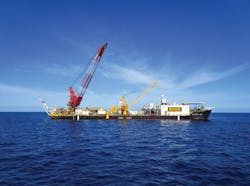BOEM issues final five-year OCS leasing program
US offshore oil and gas development will remain focused in the Gulf of Mexico, at least in the near term.
In mid-November, US Secretary of the Interior Sally Jewell and Bureau of Ocean Energy Management (BOEM) Director Abigail Hopper released the proposed final 2017-2022 outer continental shelf oil and gas leasing program.
It offers 11 potential lease sales in four planning areas - 10 sales in the portions of three Gulf of Mexico program areas that are not under moratorium and one sale off the coast of Alaska in the Cook Inlet program area. However, the Beaufort and Chukchi seas planning areas in the Arctic as well as the Pacific and Atlantic OCS are not included in the program.
Secretary Jewell said: “The plan focuses lease sales in the best places - those with the highest resource potential, lowest conflict, and established infrastructure - and removes regions that are simply not right to lease. Given the unique and challenging Arctic environment and industry’s declining interest in the area, forgoing lease sales in the Arctic is the right path forward.”
The secretary may approve the final program after a minimum of 60 days; the plan would then become effective on July 1, 2017.
BOEM Director Hopper added: “The plan was informed by robust stakeholder engagement and the best available science. The proposal makes available more than 70% of the economically recoverable resources, which is ample opportunity for oil and gas development to meet the nation’s energy needs.”
Many industry associations quickly issued responses to the proposed final program, and many of these were critical.
Independent Petroleum Association of America President and CEO Barry Russell said: “The administration should allow more access to our vast energy resources, not less. It’s disappointing that this administration, with just two months left in office, has chosen to take the low, politically-motivated path and dictate the nation’s offshore program for the entirety of President-elect Trump’s four-year term.”
National Ocean Industries Association President Randall Luthi was critical of the administration’s decision to eliminate lease sales in the Beaufort and Chukchi seas from the final 2017-2022 OCS oil and gas leasing program. Luthi said that the decision “threatens US energy security, pulls the rug out from under Alaskans, and is a slap in the face and for consumers in the US and throughout the world. While countries such as Norway, Russia, and even China are ramping up their presence in the Arctic, the US will have to play catch up. Finalizing the 2017-2022 OCS leasing program without including the Beaufort and Chukchi seas means the race has started and the US is not even on the track.”
Consumer Energy Alliance President David Holt added: “This decision threatens to undermine and reverse historic economic, societal, and environmental gains we’ve made thanks to the US energy revolution. The administration has failed to present a serious offshore leasing plan that will help meet our nation’s long-term energy needs by caving to the demands of anti-development extremists and further restricting offshore leasing through 2022. The next administration will soon have an opportunity to change course by taking a much more responsible approach. The economic well-being and quality of life of the American people and businesses, especially those in Alaska, depend on it.”
Drilling permits increase again
The number of approved US offshore drilling permits has moved upward for a third consecutive month, according to Evercore ISI’s latest US Drilling Permit Monthly Report.
Although down 49% year-over-year, October’s Gulf of Mexico permit numbers totaled 16 new permits. That number represents a 60% sequential growth from 10 in September.
Deepwater permitting activity showed the strongest bounce back from last month, the update found, with two new wells and four bypass projects permitted. New well permits held flat quarter-over-quarter at six: There were two incremental adds in ultra-deepwater and one in deepwater, from one in September to two in October.
October’s side track permits totaled four, compared to three in September. Once again, the analyst firm cautioned that the sharpest decline year-over-year has been the shallow-water permitting, down 71% from this time last year. No new well permits were issued for shallow-water wells, down 85% from 2014.
The analyst noted that offshore drilling will continue to show depressed activity as long as shallow water permits remain at historically low levels.
The group updated on another bright spot for the market. “Offshore planning suggests some positivity moving forward, with BHP Billiton filing 28 well permits from midwater work in 1H 2017. Overall, we remain cautious in allocating optimism to the offshore space, but permitting trends have certainly shown upward momentum over the past three months,” the update noted.


